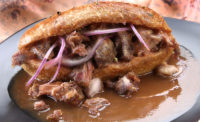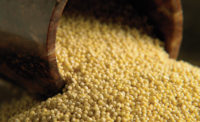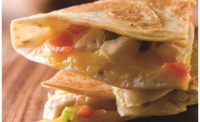Breaking bread. Bread-and-butter. The best thing since sliced bread.
What do these idioms have in common? They all recognize that bread is a staple of Americans’ diets, with the ability to lay the foundation of a meal and transform tradition with the slightest change in trend. Still, despite its “staple” status, the bread category has been relatively stagnant for the past year, according to IRI, Chicago, whether it’s fresh bread (up 0.34 percent), hamburger or hot dog buns (up 1.57 percent ), rolls (up 0.41 percent from last year), or even frozen bread and dough (up 0.13 percent).
“Sales have been stagnant to declining within breads for several years,” says Abby Ceule, director of market management breads, Corbion, Lenexa, KS. “Declines were offset by increased pricing, and recently, volume declines have leveled for the most part.”
While consumers haven’t necessarily left the category, Ceule explains, they have changed their buying habits to reflect less-frequent purchasing. “Where a household may have bought a loaf every five days,” she adds, “they are now buying every seven to eight days, leading to overall weaker sales.”
Even so, it is an exciting time to be in the bread category, as changes in consumer expectations, trends, ingredients and varieties encourage innovation like never before.
Trend overlap
“The bread market is changing, and we have seen a major shift in what consumers want,” says Jim Bohrer, senior vice president of technical services, AB Mauri North America, St. Louis. “The demands of traditional breads that once drove growth in the industry have been replaced by new products such as cleaner-label, organic, gluten-free and artisanal bread solutions.”
Indeed, clean-label and nutritional trends may take the shape of high protein, fiber and nutrient content on the shelf, says Jeff Billig, vice president and general manager, Delavau Food Partners, Philadelphia. “From an experience angle, breads aren’t just bookends for sandwiches,” he adds. “They can deliver as much to a meal as the other foods on the plate.”
Some breads have grown more specialized. “The most significant trends today have to do with organic, non-GMO and all-natural lines of baked goods,” says Dean Modglin, wholesale sales director, Lesaffre Yeast Corp. and Red Star Yeast Co., Milwaukee. “Some consumers are turning toward artisan breads, which are usually made with fewer ‘chemicals’ and more natural ingredients, while others are looking to reduce certain aspects, such as gluten, salt, sugar, fat and artificial additives.”
What this means for bakers is that while non-GMO, all-natural, organic, healthy and artisan each represent a unique trend in the bread market, definitions aren’t yet set and the overlap is undeniable. By its very nature, artisan, for example, hits on trends like handmade, fewer and recognizable ingredients, clean-label, unique flavors and better-for-you.
To that end, Lesaffre and Red Star Yeast recently launched Saf-Pro Relax 200, an inactive yeast and clean-label dough relaxer that can replace chemicals like L-cysteine and sodium metabisulfite, as well as Sprouted Malt Wheat and Arome Levain natural sourdoughs, which contain fermented flours to offset artificial flavors like fumaric acid and citric acid.
Delavau is meeting the better-for-you trend with Harmony technology, designed to optimize the cost-in-use of formulations with clean labels, as well as Accent calcium fortification, offering formulators the opportunity to launch bread products with the levels of calcium found in a glass of milk.
At Brolite Products Inc., Streamwood, IL, clean label takes center stage, with bread bases like Natural 2, a 2 percent clean-label, no-time dough conditioner that works in pan, hearth and artisan breads; SFW 125, a clean-label dough strengthener used at 0.125 percent; and CL Pan Bread Base, a clean-label base for pan breads, soft rolls and buns. “Consumers are looking to see if the ingredients are ones they recognize,” says the company’s president, David DelGhingaro. “They want to be able to understand food labels without being a food scientist or cereal chemist.”
Perhaps that’s why, in a flat category, brands like Cobblestone Bread Co. (up 115 percent in the fresh rolls/buns/croissants category), Dave’s Killer Bread (up about 31 percent in fresh bread) and Nature’s Own all coming out of Flowers Foods, Thomasville, GA, are experiencing immense growth.
“Since their debut in 1977, Nature’s Own products have never had any artificial preservatives, colors or flavors,” says Brad Alexander, executive vice president and CEO, Flowers Foods. “They also have no trans fat or cholesterol, are low in fat, and are made without high-fructose corn syrup.”
Cobblestone Bread Co. was created by Flowers Foods in 2014 to appeal to millennials and foodies, specifically. When Flowers Foods realized that these smaller households were frustrated with the regular sizes of most loaf breads, the company addressed the concern by rolling out “right-sized” loaves. “With a few less slices than a normal-sized specialty loaf, and an attractive price point, these right-sized loaves are driving the specialty premium loaf category growth in units, and contributing significantly to dollar growth,” says Alexander, all while offering a unique, artisan-like experience.
Indeed, many better-for-you products also hit on the artisan trend, since the term “artisan” evokes unique, small-batch and clean-label, made in a home kitchen with ingredients that consumers recognize. The good news is that getting an artisan feel is no longer relegated to Grandma’s kitchen.
“At one point, artisan breads were completely handmade with long ferments,” says DelGhingaro. “Now, with more advanced technology—in both ingredients and equipment—wholesale bakers are able to produce these breads in much larger quantities without sacrificing quality.”
The artisan trend also allows for bakers to stretch their wings with variety, from ingredients like amaranth and chia to finished products like naan and pitas, appealing to a desire for specialty products. According to NPD Group, today just 69 percent of homemade sandwiches are prepared with commercial, sliced loaf breads, compared to 83 percent just 30 years ago.
“Some feel these breads have a healthier profile, while others like the taste more than standard white or wheat bread,” explains Ceule. “We’ve heard people say, ‘Bread is boring,’ and they want additional options for themselves and their families.”
Looking to the future
Amid this hybrid trend lies undeniable challenges, the first of which starts on the production line. “When you remove all the conditioners and ingredients to help sustain a dough through a punishing process and for shelf life, these doughs become harder and harder to process through conventional bread equipment,” says Eric W. Riggle, vice president, Rademaker USA, Hudson, OH. The company’s recent Rademaker DSS dough sheeter is designed to process all types of high-quality artisan doughs, from baguettes to ciabatta and beyond.
Further, as consumers demand a reduction in “bad” ingredients like sodium or fat, a product’s ingredient profile changes. “These types of products require different investments in ingredients and equipment manufacturing to reflect a new, nontraditional bread piece,” adds Bohrer.
And, finally, once a product hits the shelf, confusion in terminology adds further barriers: “What is clean-label? What is all-natural? What is artificial?” asks Modglin. “There is a lot of misconception, because most people really don’t know. That’s the big challenge.”
The good news is that this industry has never shied away from a challenge. And with a shifting market comes great opportunity, says Billig, both in terms of trending breads (think wraps and flatbreads) as well as new ingredients. “The brands that use this chance to proactively innovate—by giving their breads greater nutrition claims, a cleaner label, a fresher taste—are going to come out ahead,” he says.
“My outlook for the future is positive,” says Michael Heimink, technical application manager, Pak Group, Pasadena, CA. “I look forward to the new concepts and solutions the industry will undoubtedly offer consumers in the future, as I believe bread products will always play an important role in the daily diets of people from all around the world. Especially now, when a delicious recipe used by a grandmother in, let’s say Croatia, can be produced by a baker in Long Island, NY, and be sold in stores anywhere from Seattle to Tallahassee, FL.”















